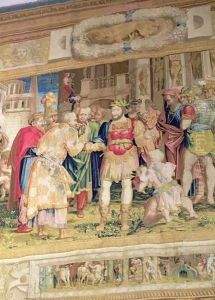Rosso, Giovanni Battista Paintings
Giovanni Battista di Jacopo, known as Rosso Fiorentino or Il Rosso ('the Redhead'), was an Italian Mannerist painter, born in Florence in 1494. His nickname, 'Fiorentino', references his birthplace, while 'Il Rosso' likely refers to his distinctive red hair. Early in his career, Rosso was influenced by the works of Andrea del Sarto, Leonardo da Vinci, and Raphael, but he soon developed a highly individual style characterized by dramatic use of perspective, elongated figures, and a bold, sometimes eccentric, use of color that set him apart from his contemporaries.
Rosso's career can be divided into two main periods: his work in Italy and his later work in France. In Italy, Rosso was part of the vibrant Florentine art scene, where he completed several notable works, including the 'Assumption of the Virgin' for the Annunziata in Florence, a commission he received in 1513 which was later removed and lost. His most famous Italian work is probably the 'Deposition from the Cross' for the church of San Lorenzo in Volterra, completed in 1521. This painting exemplifies Rosso's dramatic style, with its emotional intensity, stark lighting, and complex composition.
In 1530, after the Sack of Rome, during which Rosso suffered personal losses, he moved to France, where he entered the service of King Francis I. This marked the beginning of his second major phase. In France, Rosso was appointed as one of the first artists to work on the decoration of the Château de Fontainebleau, which became a center for the new style of French Renaissance art, heavily influenced by Italian Mannerism. Rosso's work at Fontainebleau, especially his contributions to the Gallery of Francis I, was pioneering. His designs, which included wall paintings, stucco decorations, and intricate frescoes, were marked by their inventiveness and the integration of the arts into a cohesive whole, influencing the development of the School of Fontainebleau.
Rosso Fiorentino's innovative approach to composition, color, and form had a significant impact on the development of Mannerism in both Italy and France. His work is characterized by its emotional intensity, complex allegories, and a striking, sometimes unsettling, aesthetic that challenged Renaissance ideals of harmony and proportion. Despite his relatively early death in 1540, Rosso's legacy lived on, influencing not only his contemporaries but also future generations of artists. His contributions to the art of the French Renaissance remain particularly noteworthy, marking him as a key figure in the transition between the High Renaissance and Mannerism.
